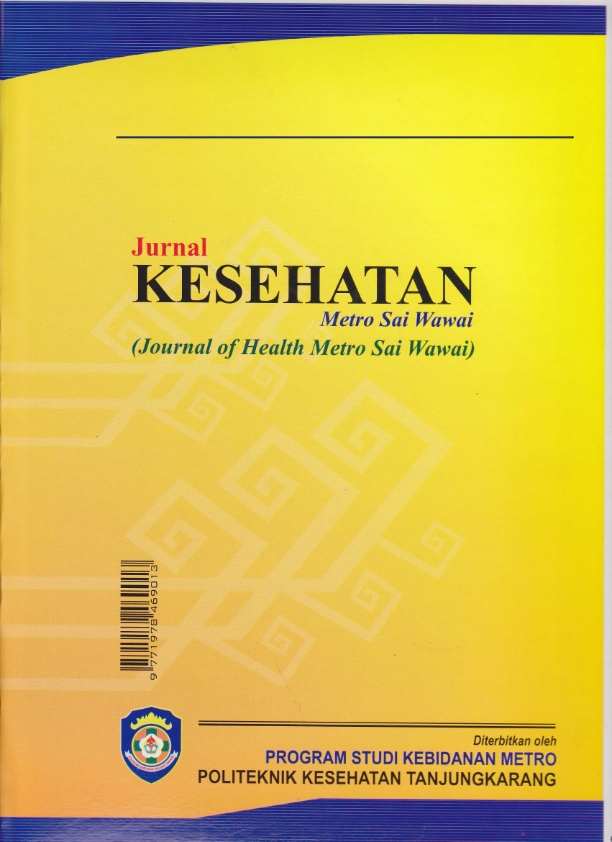The Impact of the Combination Therapy of Listening to the Holy Quran and Progressive Muscle Relaxation on Blood Pressure Reduction in Women of Reproductive Age with Hypertension: A Randomized Controlled Trial Study
DOI:
https://doi.org/10.26630/jkmsaw.v17i1.4514Keywords:
Blood pressure, complementary therapy, hypertension, Holy Qur'an, progressive muscle relaxation.Abstract
Introduction: Hypertension is a global public health problem, including Indonesia as a silent killer. Nonpharmacological (complementary) therapies are experiencing an increasing trend to be given along with pharmacological therapy requires evaluation as a blood pressure lowering for evidence-based practice. Objective: To evaluate the effect of combined therapy of listening to the Holy Quran and progressive muscle relaxation (PMR) on lowering blood pressure in women of reproductive age with hypertension. Methods: The research design used a quasi-experimental study with a pretest-posttest control group design approach. Women of reproductive age with mild and moderate hypertension in the experimental and control groups, a total of 21 participants each, were carried out at the Community Health Center in Metro City, Indonesia. Participants were given audio or listening to the Holy Quran and RPO as an experimental group and standard hypertension drug therapy in the control group. Mann-Witney test to prove the hypothesis with a significant level < 0.05 was chosen as statistical analysis. Results: This study found that women of reproductive age who were given a combination therapy of listening to the Holy Quran and PMR affected lowering their blood pressure (p-value 0,001). Participant, after being given the treatment, experienced a decrease in systolic blood pressure of 15,71 mmHg (CI 95%: 13,77-17,66) and diastolic 10,71 mmHg (CI 95%: 9,41-12,02). Conclusion: Nonpharmacological therapy (complementary) of listening to the Holy Quran audio and PMR given simultaneously can reduce blood pressure in women of reproductive age with hypertension. Therefore, this complementary therapy can be used as a companion therapy along with conventional therapy for community health services.
Latar Belakang: Hipertensi menjadi masalah kesehatan masyarakat global, termasuk Indonesia sebagai silent killer. Terapi nonfarmakologi (komplementer) mengalami trend peningkatan untuk diberikan bersamaan dengan terapi farmakologi memerlukan evaluasi sebagai penurun tekanan darah untuk evidence base practice. Tujuan: Untuk mengevaluasi efek terapi kombinasi mendengarkan Al-Qur’an dan relaksasi otot progresif (ROP) terhadap penurunan tekanan darah pada wanita usia subur dengan hipertensi. Metode: Rancangan penelitian menggunakan studi quasi eksperimen pendekatan pretest posttest control group design. Wanita usia subur dengan hipertensi ringan dan sedang pada kelompok eksperimen dan kontrol masing-masing total 21 sebagai Partisipan yang dilaksanakan di Pusat Kesehatan Masyarakat di kota Metro, Indonesia. Partisipan diberikan terapi audio mendengarkan al-quran dan ROP sebagai kelompok eksperimen dan pemberian terapi obat standar hipertensi pada kelompok control. Uji mann-witney untuk membuktikan hipotesis dengan tingkat signifikan < 0,05 dipilih sebagai analisis statistic. Hasil: Studi ini menemukan bahwa ada pengaruh wanita usia subur yang diberikan terapi kombinasi mendengarkan al-quran dan ROP terhadap penurunan tekanan darah (p-value 0,001). Partisapan setelah diberikan perlakuan mengalami penurunan tekanan darah sistolik 15,71 mmHg (CI 95%: 13,77-17,66) dan diastolic 10,71 mmHg (CI 95%: 9,41-12,02). Simpulan: Terapi nonfarmakologi (komplementer) mendengarkan Al-Qur’an dan relaksasi otot progresif yang diberikan bersamaan mampu memberikan efek penurunan tekanan darah pada wanita usia subur dengan hipertensi. Oleh karena itu, terapi komplementer ini dapat dijadikan terapi pendamping bersamaan dengan terapi konvensional untuk pelayanan kesehatan komunitas.
References
Achadi, E. L. (2019). Kementrian kesehatan Republik Indonesia. http://www.kemkes.go.id
Alwi, J., Sari, M., Adnyana, I. M. D., Rustam, M., Rahayu, D., Irma, Febriyanti, Astuti, N., Rahmawati, Rangga, Y., Dara, W., Pongoh, L., Manoppo, J., Anulus, A., Rahmah, A., Setiaji, B., Arfan, I., Ayu, J., Yuhadi, A., & Ibrahim, M. (2023). Metode Penelitian Epidemiologi. https://www.researchgate.net/publication/ 376518753_Metode_Penelitian_Epidemiologi/citation/download
Baharuddin, K. P., & Suwandi, D. (2013). Perbandingan efektifitas dan efek samping Obat Anti Hipertensi terhadap Penurunan Tekanan Darah Pasien. Master Tesis Program Biomedik, Universitas Hasanudin. http://repository.unhas.ac.id/id/eprint/9360/2/baharuddin-1898-1-13-bahar-2%201-2.pdf
Black, J, M., & Hawks, J. H (2014). Keperawatan Medikal Bedah Manajemen Klinis untuk Hasil yang di Harapkan. Singapura: Elsevier http://opac.nhm.ac.id//lib/phpthumb/phpThumb.php?src=../../images/docs/kmb_black.jpg
Damanik, H., & Ziraluo, A. (2018). Pengaruh Teknik Relaksasi Otot Progresif Terhadap Penurunan Tekanan Darah Pada Pasien Hipertensi. Jurnal Keperawatan Priority, 99-102. Retrieved from http://jurnal.unprimdn.ac.id/index.php/jukep/article/view/195
Dinkes-Kota-Metro. (2023). Profil Kesehatan Kota Metro Tahun 2022. Dinkes Kota Metro.
Dinkes-Provinsi-Lampung. (2020). Profil Kesehatan Provinsi Lampung 2019. Dinkes Provinsi Lampung.
Kemenkes RI. (2019). Pusat Data dan Informasi Kementerian Kesehatan RI Hipertensi Si Pembunuh Senyap. Retrieved from https://pusdatin.kemkes.go.id/resources/download/pusdatin/infodatin/infodatin-hipertensi-si-pembunuh-senyap.pdf
Kemenkes. (2020). Profil Kesehatan Indonesia Tahun 2019. https://www.kemkes.go.id/Downloads/Resources/Download/Pusdatin/Profil-Kesehatan-Indonesia/Profil-Kesehatan-Indonesia-2019.Pdf
Kemenkes, R. I. (2018). Hasil utama RISKESDAS 2018. In Kemenkes RI. https://kesmas.kemkes.go.id/assets/upload/dir_519d41d8cd98f00/files/Hasil-riskesdas-2018_1274.pdf
Maring, F. N. A., Purnawan, S., & Ndun, H. J. N. (2022). Faktor Risiko Kejadian Hipertensi Pada Wanita Usia Subur Di Wilayah Kerja Puskemas Naibonat. Jurnal Riset Rumpun Ilmu Kesehatan (JURRIKES), 1(1), 19–26.
Purwono, J., Sari, R., Ratnasari, A., & Budianto, A. (2020). Pola konsumsi garam dengan kejadian hipertensi pada lansia. Jurnal Wacana Kesehatan, 5(1), 531–542.
Rosdiana, E., & Ishak, S. (2019). Faktor Resiko Terjadinya Hipertensi pada Wanita Usia Subur di Desa Lampenuerut Kecamatan Darul Imarah Aceh Besar. Journal of Healthcare Technology and Medicine, 5(1), 62–71.
Rosyid, A. (2023). Hubungan Penggunaan Kontrasepsi Hormonal dengan Hipertensi Pada Wanita Usia Subur. Nutrix Journal, 7(1), 84–89.
Putri, N. G., Herawati, Y. T., & Ramani, A. (2019). Peramalan Jumlah Kasus Penyakit Hipertensi Di Kabupaten Jember Dengan Metode Time Series. Journal of Health Science and Prevention, 3(1), 39-46. https://doi.org/10.29080/jhsp.v3i1.161
Soewondo, S., Menaldi, A., & Hanum, L. (2017). Stress, Manajemen Stress, dan Relaksasi Otot Progresif. LPSP3 UI.
Tyani, E. S., & Hasneli, Y. (2015). Efektifitas Relaksasi Otot Progresif Terhadap Tekanan Darah Pada Penderita Hipertensi Esensial. Jurnal Online Mahasiswa (JOM) Bidang Ilmu Keperawatan, 2(2), 1068-1075. https://jnse.ejournal.unri.ac.id/index.php/JOMPSIK/article/view/8270
WHO. (2019). Hypertension. https://www.who.int/news-room/fact-sheets/detail/hypertension
WHO. (2020). Hypertension. https://www.who.int/news-room/fact-sheets/detail/hypertension
WHO. (2023). Hypertension. https://doi.org/Mills, K. T., Stefanescu, A., & He, J. (2020). The global epidemiology of hypertension. Nature reviews. Nephrology, 16(4), 223–237. https://doi.org/10.1038/s41581-019-0244-2
Downloads
Published
Issue
Section
License
Copyright (c) 2024 Erna Ningsih, et al.

This work is licensed under a Creative Commons Attribution-NonCommercial 4.0 International License.

Jurnal Kesehatan Metro Sai Wawai is licensed under a Creative Commons Attribution-NonCommercial 4.0 International License.






